
Before I begin, I want to cover cylinder-to-bore alignment. Conventional wisdom says line-boring is the most precise method to index the cylinder throat and barrel’s bore. I’ll flatly tell you it isn’t. That’s no knock on the process or any of the fine gunsmiths that use the technique. If I built custom revolvers for sale, I’d damn sure advertise line-boring. It’s universally accepted as the gold-standard. It sells.
Line-boring is done in a horizontal mill using a frame/cylinder jig. A spud is first screwed into the frame which acts as the drill guide. The gun is held in battery and a centering drill spots the bore’s centerline. You can either drill one pilot hole per chamber and pull the cylinder or progressively increase the diameter. Regardless, with line-boring you can’t complete the pilot hole; otherwise you’d run into the breech face. Line-boring also requires a bearing block to wedge the bolt and a tightly fit basepin. That ensures indexing is consistent chamber to chamber. It supplements how the cylinder is kept stationary while cocked for drilling. Most of the work though is done by a jig which secures the frame and cylinder. While line-boring is quite precise, it presents some challenges;
• The frame jig must hold the action dead perpendicular to the mill’s head. If you decide to get into a line-boring, you’ll spend some time getting this right.
• The centering bit and pilot drill cannot be the exact diameter of the guide spud’s hole. If they were, they’d drag the edge. So they must be undersized by a thousandth or so. Alignment much past three zeros becomes difficult.
• The pilot holes must be re-indicated with a centering device to complete the bore (cylinder outside of the frame). Thus you’re drilling in two passes. This introduces the chance for slight misalignment upon re-centering (even as the drill follows the pilot hole)
• Frame and cylinder jigs are very rigid. However, they do not compare to the leveling capability and positive grab of a 100 pound, 3 or 4 jaw chuck.
By now, I’m sure some of you are shaking your head. Fine enough, but we’ve both line-bored and cut cylinders with the method outlined below. My conclusions are based on actually shop time, not conjecture.
__________________________________________________
Line Indexing
We didn’t invent the process, but my dad switched to line-indexing on his own in the 1990’s. After dozens of conversions, we found it easier and more accurate than line-boring. It all starts with sound cylinder fit. As illustrated in step #6, the bolt matches the frame slot and notches so there is absolutely no side-play. We also use the same oversized pin for indexing mock-up. Dad machined a frame mounted shank, made with extremely tight threads. It was center bored and honed to 0.2500” on the nose. Next he cylindrically ground a pointed rod, once again 0.2500” diameter. Key takeaways: 1) The point was indexed and zeroed to absolute center, and 2) The rod is so tightly fit there’s resistance when pushing it through the hole (unlike line-boring shanks which are a thousandth or two larger than the drill).
The homemade frame spud.
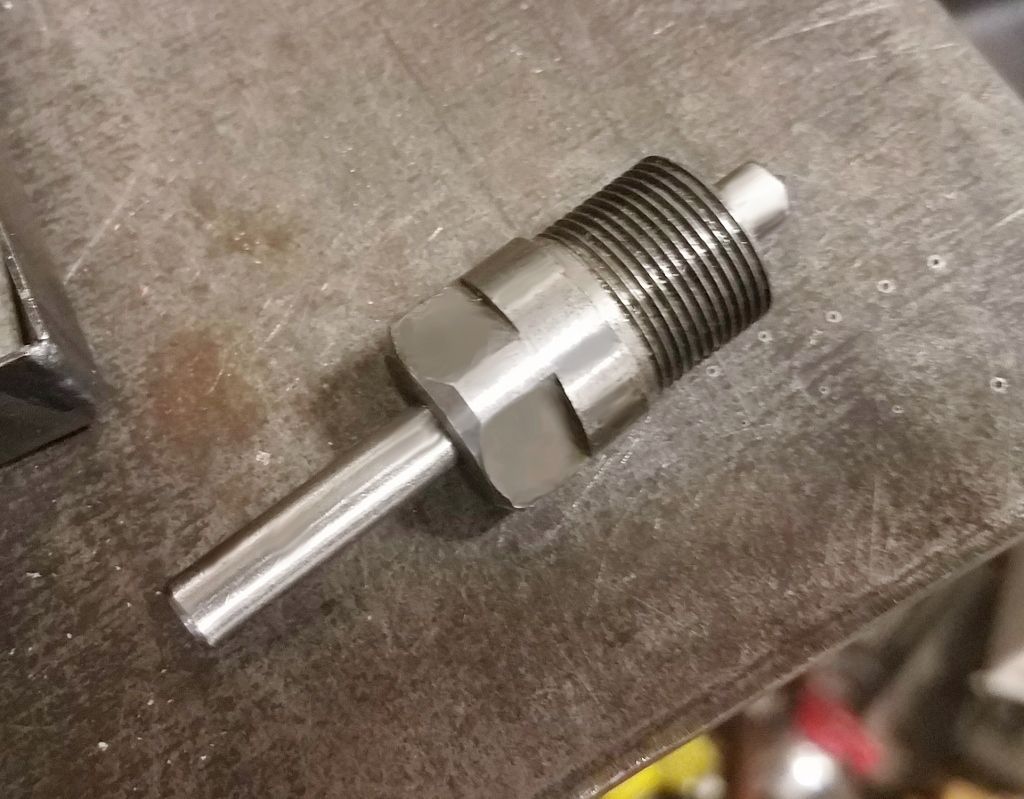
The shank is threaded into the frame and the rod is inserted. With the gun in battery, the rod is tapped and the fine indication point marks the cylinder face. This is repeated five times.

A Hartford Super Spacer is mounted on our Bridgeport. The chuck weighs 100 pounds and is accurate to seconds of a degree. The chuck had already been leveled to the table.
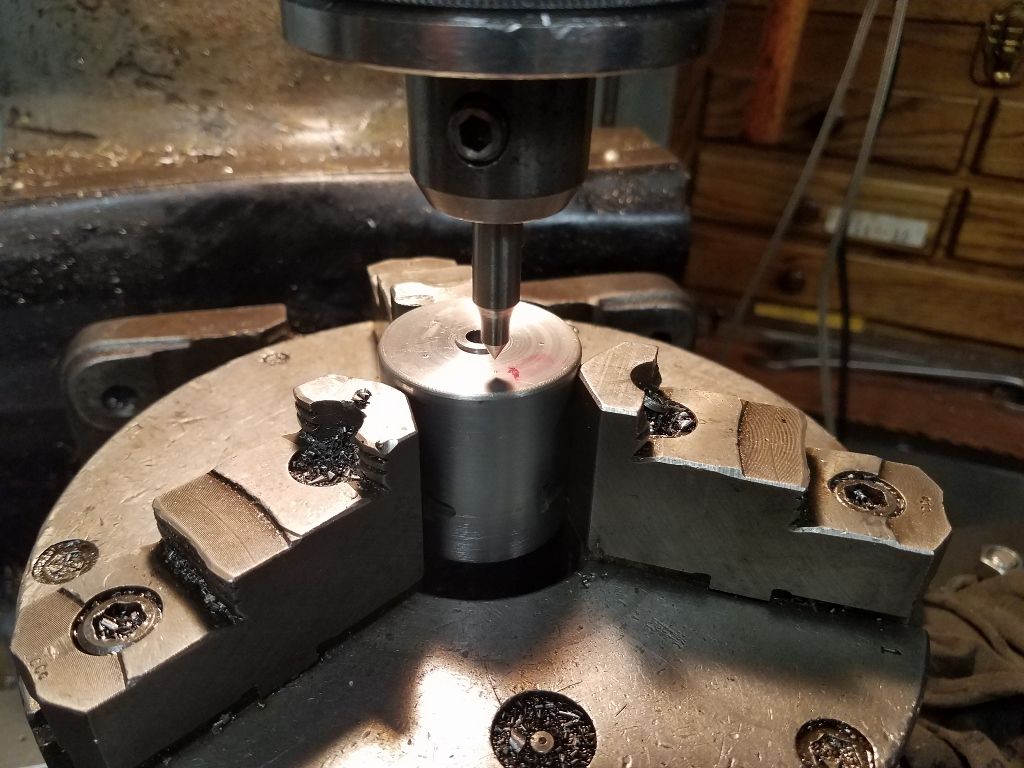
A Baker centering gauge is installed and the point is put in the indentation. Each mark on the gauge represents 0.0005”. The mill is turned on a very slow speed and the dial indicates misalignment. The table is adjusted in tiny graduations until the needle doesn’t move as it spins in the mark. Once it stays on the same dial mark, you’re indicated to 0.0000”.
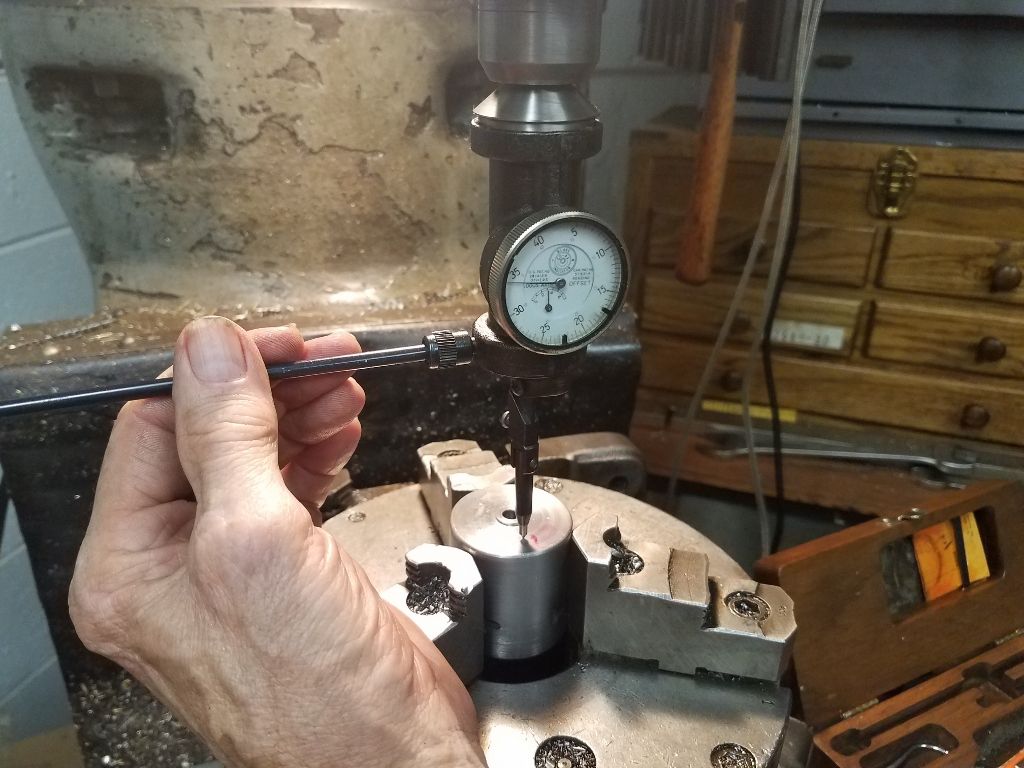
The mark is spotted with a starter bit. This is followed by a 1/4” drilled hole front to back.
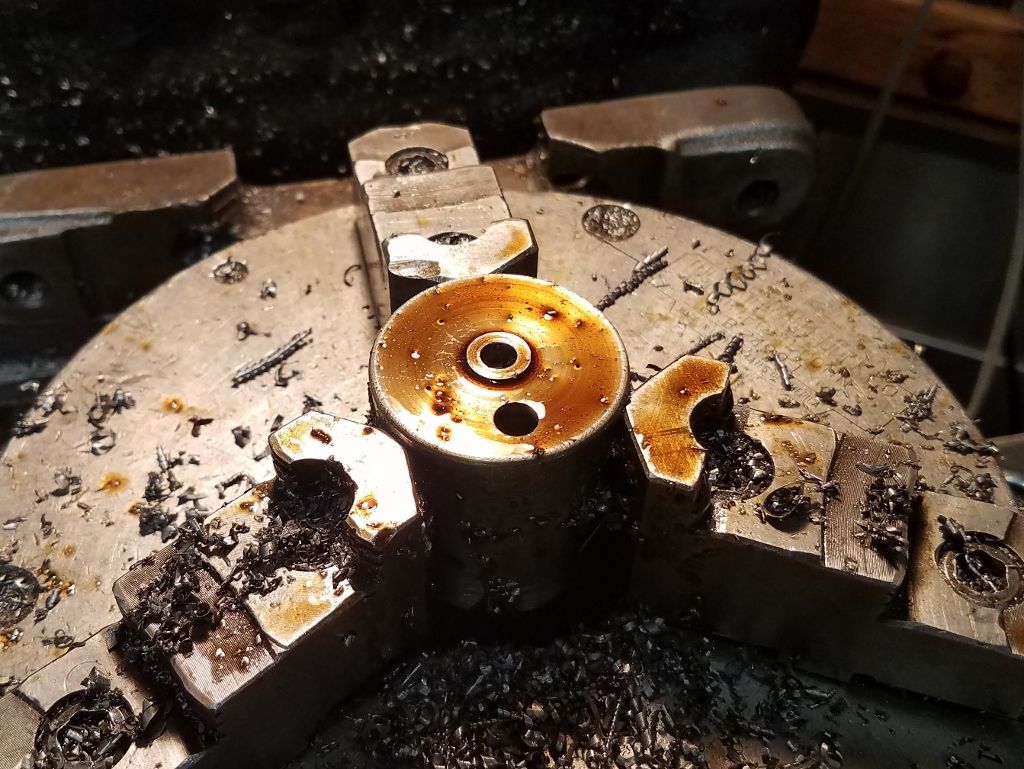
I then enlarged the hole with a 31/64” bit (0.4844”).

A 0.510” reamer makes the final pass. This reamer was ground by my dad and matches our .500 Linebaugh pilot; also home ground.
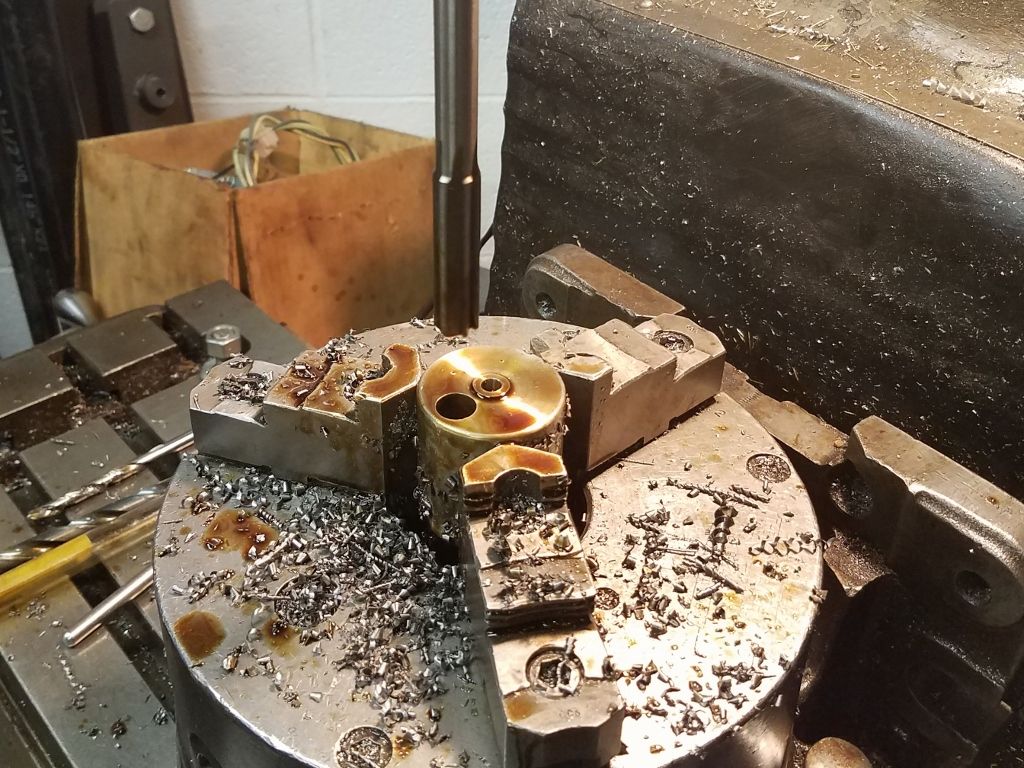
I purposely reamed the throat under final spec. We prefer honing the throats to the desired diameter, approximating the bullet. This allows us to achieve tighter tolerances and produces a superior surface finish.
Video of me reaming a throat. Forgive the shakiness, I was holding the camera as I feed the reamer.
The process is repeated 4 times after the indexing head is rotated 72 degrees. Integral to proper alignment is re-indicating each mark with the centering gauge.
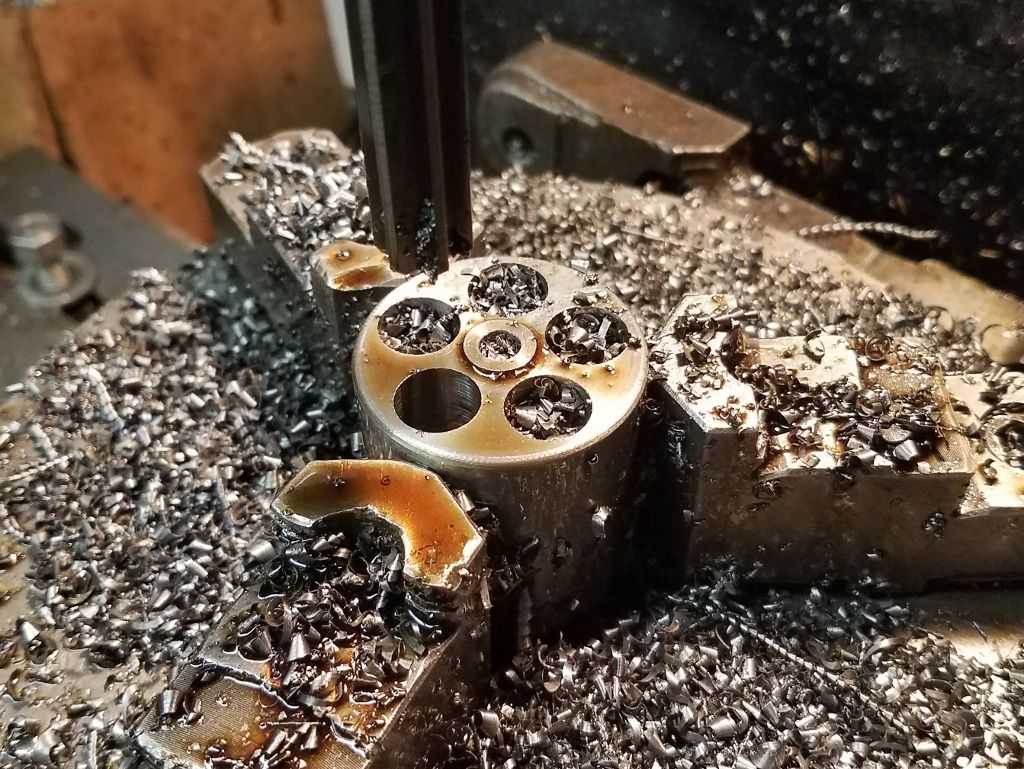
Checking throat-to-bore alignment – saying one method is better than the other means nothing without empirical evidence. The best way to do that is with a centering device. You start with a frame shank sporting a hole that exactly matches the throat. For example, if the throat measures 0.5100”, the shank’s bore also has to be 0.5100”. The cylinder is fit to the frame, the shank is screwed in, and the gun is cocked while held in a vertical mill. Using another centering device that rides the surface of the shank’s hole, the headstock is slowly fed down and zeroed. As it transverses the cylinder gap, it enters the throat. Misalignment, or lack thereof, is shown on the dial. Meaning if it stays zeroed in the throat over 360 degrees, you’re dead nuts on. If there’s runout, it’ll show-up on the dial.
Bore alignment – line indexing or line-boring are tied to barrel installation. Remember, we’re talking throat to barrel bore alignment here. If you thread the blank and lathe the cone with any runout to center, you’re nixing the precision throat. A lot of guys index on the outside of the blank when adjusting the chuck. Forget that. Even the highest quality blanks exhibit a thousandth or two of O.D. runout to the rifled bored. And most of the pistol blanks we use show 0.002” – 0.004” runout over the entire length. I’m a stickler on this, but you really need to center the blank in the chuck by zeroing across every groove. When I barrel this thing, I’ll detail those steps.
A couple of things to back my point. Magnum Research uses line-indexing on their BFRs, albeit in a more automated fashion. We all know how well they shoot. And earlier this year I was talking to a friend who is one of the most talented gunsmiths I know. He doesn’t commercially smith, but has done everything from custom built benchrest actions to Ruger conversions. For a living he builds engine balancing machines that he and his brother designed….that speaks to his engineering prowess. Anyway, we were talking about line-boring Rugers when he said there’s a better mousetrap. I didn’t say how we did ours, instead giving him the floor. After five minutes of explaining his approach, it turns out he uses the same method we do to indicate bore centerlines. We’re not alone on this one.
-Lee
www.singleactions.com"Chasing perfection five shots at a time"